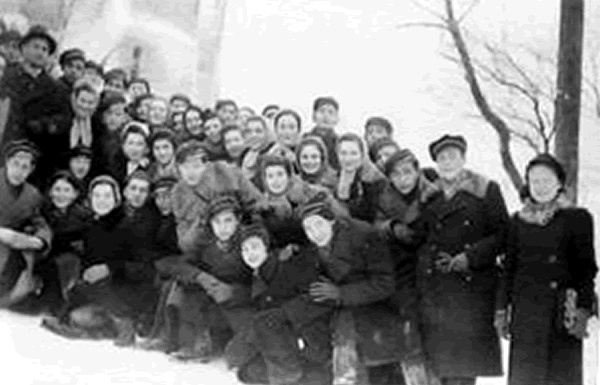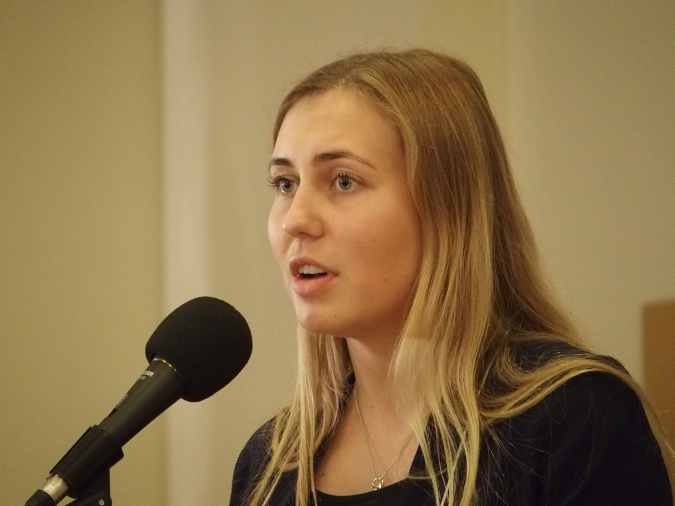The Tolerance Center of the Vilna Gaon Jewish State Museum hosted a presentation by director Markas Zingeris of plans to restore the museum’s building at Pylimo street No. 4 in Vilnius for use as a new museum of Litvak culture and achievements December 3.
Currently the building is mostly empty but formerly housed the museum’s History Department and Gallery of the Righteous. It is actually part of the same building now as the Lithuanian Jewish Community and is connected by corridors with the LJC. Formerly it was the Tarbut Gymnasium or high school established after World War I. The name of the proposed new center is the Center of Litvak Culture and Art.
Zingeris’s plan includes showcasing famous Litvaks who have contributed to culture and science and he presented a number of figures including Nobel Prize winners for inclusion. He emphasized the need to teach the Lithuanian public about Litvak achievements as part of their own history. He also had a map projected onto the overhead screen showing other Jewish cultural museums in Europe and spoke specifically about Vilnius’s place on “the Northern European Jewish route.” Whether this “route” is an official EU program or not wasn’t made clear.
A number of speakers took the podium after the director, including chairman of the Lithuanian parliamentary Education, Science and Culture Committee MP Raimundas Paliukas; chargé d’ affaires of the Polish embassy in Vilnius Maria Ślebioda; private attorney and collector Rolandas Valiūnas; Ieva Pakarklytė, advisor to mayor of Vilnius Remigijus Šimašius; Lithuanian Jewish Community chairwoman Faina Kukliansky and MP Emanuelis Zingeris. All the speakers had their words translated synchronously into Lithuanian and English.
There was almost unanimous consent among the speakers a new Litvak Center would be a good thing with the only voice of slight dissent coming from LJC chairwoman Faina Klukliansky, who said what was really needed was a Jewish museum which included everything, not just culture. She said Vilnius needed a large central Jewish museum which would cover culture, the Holocaust, religion and all aspects of Jewish life in Lithuania. She also noted the proposed new center was in the same building as LJC headquarters and would need the same sort of renovation the LJC currently needs, including fixing the central boiler and radiators, presumably part of a shared central heating system.
Chairwoman Kukliansky corrected the synchronous translation at one point. “I didn’t say ‘Jewish state museum,’ I said ‘Jewish museum’,” she explained regarding her suggestion for a larger and more-inclusive Jewish museum in central Vilnius.
Remarks by Emanuelis Zingeris followed, detailing how the first post-war Jewish Museum in Vilnius was shut down and its collections transferred to other museums by the Soviet authorities. Emanuelis Zingeris was instrumental in setting up the second incarnation of the Jewish Museum in Vilnius as Lithuania pulled out of the Soviet Union and spoke about the reconstitution of the Jewish community as an institution by then-leader Algirdas Brazauskas around 1988.
A short discussion period followed. Composer, Lithuanian National Prize winner and Lithuanian Jewish Community member Anatolijus Šenderovas came up to the podium and said it wasn’t a bad thing to have a museum dedicated exclusively to culture because in his experience culture is almost always treated as an afterthought and marginalized, or at least placed at the end of the queue for funding.
There was a relatively large audience for the presentation most of whom stayed to the end when refreshments were offered and private discussions took place. The ambassador of Austria attended but did not speak.
To find out more about the Vilna Gaon Museum’s project in English, see:
http://www.jmuseum.lt/index.aspx?Element=ViewArticle&TopicID=603
For press coverage of the presentation in Lithuanian, see:
http://kultura.lrytas.lt/meno-pulsas/ar-vilniuje-pagaliau-turesime-litvaku-kulturos-ir-dailes-centra.htm



